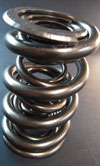Valve Spring Challenges
 There are valvetrain tricks to making good power and obtaining durability and longevity from a Dodge Mopar USAC National Midget engine, according to engine builder Bob Wirth of Hayward, California. “We need them all.”
There are valvetrain tricks to making good power and obtaining durability and longevity from a Dodge Mopar USAC National Midget engine, according to engine builder Bob Wirth of Hayward, California. “We need them all.”
The biggest problem with midget racing – like Pro Stock drag racing – is that the rate of acceleration of the engine can be exceptionally high, above 2000-3000 rpm per second. The valve spring must be able to control the mass of the valvetrain through that acceleration – on pavement and dirt.
Wirth began the process with the valve motion he wanted. Then he purchased samples of all the springs available with his proper dimension for fitment into the cylinder head, entering all the detailed information about the characteristics of these springs onto his spring dynamics software program. “This program gave us the safety margin threshold for each spring, using our valvetrain weights and target rpm of 9500 rpm,” Wirth told me.
At the time, there was only one spring that met adequate safety margins, so that was the one he used. After extended racing, though, Wirth started to experience rocker arm failure because of the cyclic fatigue of the aluminium. “Changing the rocker material to steel stopped the rocker failure, but also changed the dynamics of the valvetrain.”
Unable to figure it out, with his software not having “a provision for modulus of the material so that it could not predict this change or the increased stressed on the valve spring that caused them to fail,” Wirth contacted PSI for help with the problem.
Discussions with the engineers there indicated the types of failure Wirth was experiencing meant the “spring did not have enough rate to control the valvetrain dynamics in the engine,” Wirth said. Settling on a triple spring combination, this was tested on his spin fixture using a high-speed camera and video camera with a triggered strobe, where they watched for surge and spring rotation.
It was found that the triple spring combination had the dynamic control and fatigue cycle life to meet Wirth’s criteria of 460 service laps. “You look at it and you might like to have a threshold below one million cycles.
“When we finally did a production run of this spring,” Wirth said, “the manufacturer used their Max Life surface preparation,” (a micro shot-peening procedure) to further extend the cyclic life of the spring.”
Wirth’s Dodge Mopar is a four-cylinder midget engine of 166 cubic inches with a bore of 4.125 and stroke of 3.100. The triple spring that works for him is made of Kobe steel, “All the high-end chrome silicon wire comes from Kobe.” The Wirth way is to stiffen the valvetrain and control it dynamically with valve spring and pushrod stiffness.
The triple spring combination is heavier than any other spring Wirth uses, weighing in at 180.9 grams. “Using heavier [material] goes against contemporary thinking, but it meets our ultimate test: it works.”
Future racing challenges will also present new opportunities for him to move to new performance levels, Wirth said. “Then the process of matching valvetrain components will start all over again.”
Written by Anne Proffit.